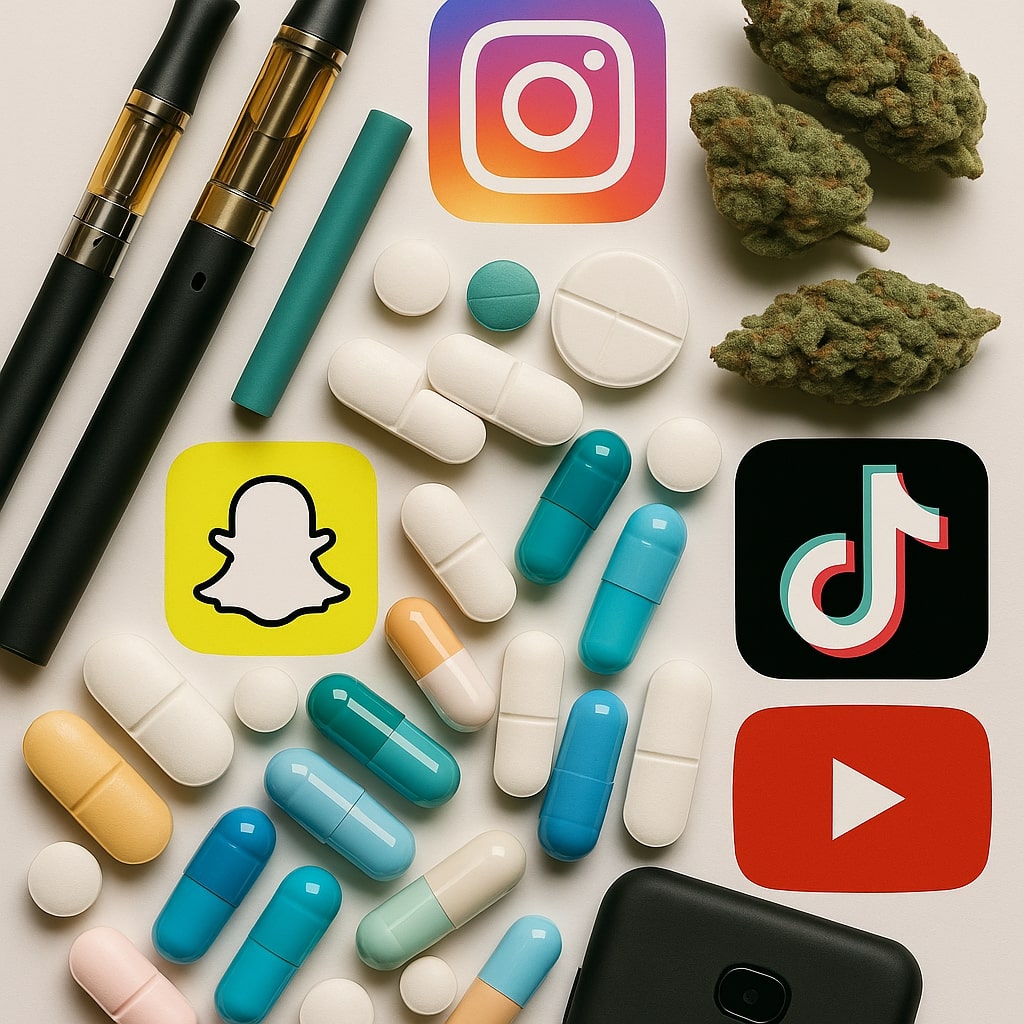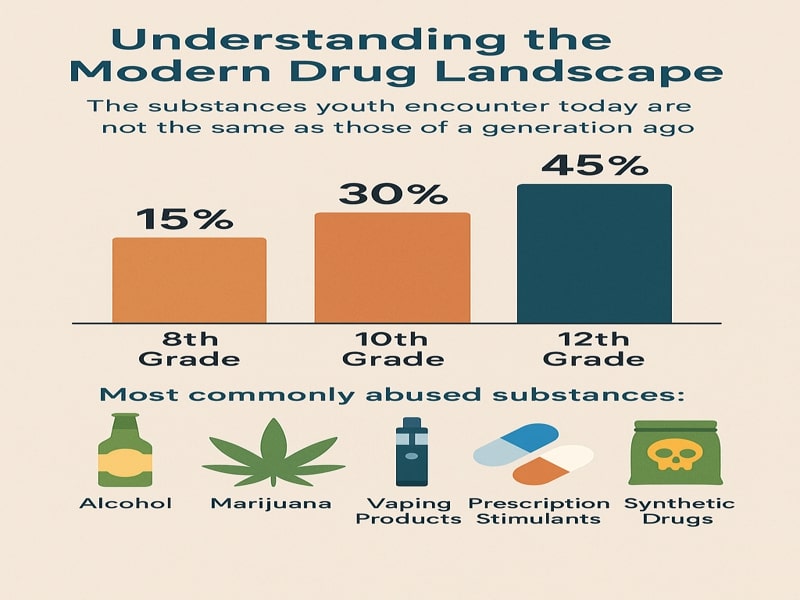
Every parent worries about their child’s safety, especially in a world where youth drug use is a growing concern. Recent data from the Monitoring the Future Survey reveals that nearly 30% of high school seniors reported using an illicit drug in the past year, with vaping and prescription drug misuse on the rise. As a rehabilitation consultant and advocate for family wellness, I understand the anxiety parents feel in the face of these statistics. The landscape of substance use among children and teens is rapidly evolving-digital access, social media, and shifting societal attitudes have made drugs more accessible and normalized than ever before.
But there is hope. Research shows that parents remain the single most powerful influence in a child’s decision to avoid drugs.
This blogpost will equip you with the latest, evidence-based prevention strategies, concrete metrics, practical examples, and visual aids to help you Prevent Child Drug Use and protect your child. By understanding the modern drug landscape and building a strong prevention foundation at home, you can significantly reduce your child’s risk of substance use. With the right knowledge and proactive steps, every parent can make a difference.
Understanding the Modern Drug Landscape

The substances youth encounter today are not the same as those of a generation ago. While alcohol and marijuana remain common, new threats have emerged: vaping devices, prescription medications, synthetic cannabinoids, and even fentanyl-laced pills. The digital age has made it easier for children to access drugs-social media platforms and encrypted messaging apps allow for discreet connections with dealers.
Current Statistics and Trends
- Age-specific data: According to the CDC, 15% of 8th graders, 30% of 10th graders, and 45% of 12th graders have tried an illicit drug.
- Most commonly abused substances: Alcohol, marijuana, vaping products, prescription stimulants (Adderall, Ritalin), and synthetic drugs.
- Digital influence: Over 40% of teens report being exposed to drug-related content online.
- Regional variations: Urban areas report higher rates of synthetic drug use, while rural communities see more prescription opioid misuse.
Risk Factors Table: Why Some Children Are More Vulnerable
| Risk Factor Category | Specific Factors | Prevention Opportunity |
| Individual | Low self-esteem, mental health issues | Building resilience |
| Family | Poor communication, lack of supervision | Creating open dialogue |
| Social | Peer pressure, desire to belong | Positive peer relationships |
| Community | Drug availability, normalization | Community involvement |
The Developmental Impact of Early Drug Use
Adolescent brains are still developing, particularly the prefrontal cortex, which governs impulse control and decision-making. Early drug use disrupts this process, increasing risks for addiction, academic failure, and mental health disorders. Studies show that teens who begin using substances before age 15 are four times more likely to develop substance use disorders as adults.
Building Your Family’s Prevention Foundation

Strong family bonds are a child’s best defense against drug use. Research consistently shows that children who feel connected to their families are less likely to experiment with substances.
Building Strong Family Bonds
- Quality time: Regular family meals, shared activities, and one-on-one time foster connection.
- Communication: Practice active listening, validate your child’s feelings, and encourage open dialogue.
- Trust-building: Show respect for your child’s opinions and privacy, and follow through on promises.
- Family rituals: Weekly game nights or shared chores reinforce a sense of belonging.
Setting Clear Boundaries and Expectations
- Develop age-appropriate rules about curfews, parties, and online activity.
- Consistently enforce consequences that teach, not punish-use logical consequences tied to the behavior.
- Involve children in discussions about rules to increase buy-in and understanding.
Parent Self-Assessment Checklist
- Do I model healthy coping behaviors?
- What messages do my habits send about substance use?
- Is our home environment discouraging experimentation?
- Are substances (alcohol, medications) easily accessible at home?
The Art of Drug Prevention Communication

How you talk to your child about drugs matters as much as what you say. Authoritative parenting-combining warmth with clear expectations-has been shown to be most effective.
Age-Appropriate Conversations Guide
- Elementary age: Focus on health, safety, and making good choices. Example: “Medicine helps when you’re sick, but only if it’s given by a trusted adult.”
- Middle school: Discuss specific substances, media literacy, and refusal skills. Example: “Some kids might offer you a vape-what could you say if that happens?”
- High school: Address consequences, harm reduction, and independence. Example: “Let’s talk about what you’d do if you’re at a party and someone offers you something.”
“The Talk” Framework
- Start early and make it ongoing.
- Use teachable moments from news or media.
- Ask open-ended questions: “What do you think about?”
- Share facts, not scare tactics.
- Emphasize immediate consequences that matter to youth (sports performance, friendships).
Handling Difficult Questions
If your child asks about your past drug use, be honest but focus on what you’ve learned and why you want something different for them. If they report peer use, listen without judgment and help them process their feelings and choices.
Recognizing the Early Signs of Substance Use
Early detection is key. Many signs of substance use overlap with normal adolescent development, but patterns and severity matter.
Physical Indicators
- Sudden changes in appearance or hygiene
- Bloodshot eyes, runny nose, or unexplained rashes
- Changes in sleep or energy levels
- Frequent illness or unexplained injuries
Behavioral Red Flags
- Declining grades or loss of interest in school
- Withdrawing from family or old friends
- Increased secrecy, especially about whereabouts or phone use
- Money issues or missing valuables
Emotional Changes
- Mood swings, irritability, or apathy
- Personality shifts or loss of motivation
Warning Signs Severity Chart
| Mild Concern | Moderate Concern | Serious Concern |
| Declining grades | Missing curfew | Finding drug paraphernalia |
| Subtle mood changes | Increased secrecy | Major personality changes |
| New friend group | Money issues | Physical symptoms of use |
| Less interest in hobbies | Breaking rules | Legal trouble |
Fostering Resilience Against Peer Influence
Peer acceptance is crucial during adolescence, making kids vulnerable to pressure. Building resilience is essential.
Strengthening Self-Esteem
- Affirm your child’s strengths and celebrate individuality.
- Encourage hobbies and interests that foster a sense of achievement.
- Teach self-compassion and internal validation.
Decision-Making Skills Development
- Practice critical thinking: “What could happen if?”
- Role-play refusal skills: “No thanks, I don’t want to mess up my sports season.”
- Discuss media portrayals of drugs and their real-life consequences.
Healthy Alternative Activities
- Encourage participation in sports, clubs, arts, or volunteering.
- Help your child find positive peer groups and mentors.
Support Network Development
- Connect with other parents and community resources.
- Foster relationships with trusted adults outside the family.
Community Partnerships in Prevention
Prevention is most effective when families, schools, and communities work together.
School-Based Prevention Programs
- Look for evidence-based curricula that teach decision-making and refusal skills.
- Advocate for comprehensive prevention education in your child’s school.
- Collaborate with teachers to reinforce messages at home.
Community Resources Directory
- Youth organizations (Boys & Girls Clubs, Scouts)
- Faith communities with youth programs
- Local prevention coalitions and support groups
Creating a Village of Support
- Organize parent networks to share information and support.
- Promote neighborhood watch-type initiatives focused on youth wellbeing.
- Ensure consistent messaging across home, school, and community.
Intervention Approaches When Concerns Arise
If you suspect your child is experimenting with drugs, respond calmly and constructively.
Approaching Initial Concerns
- Use caring, non-accusatory language: “I’ve noticed some changes and I’m worried about you.”
- Stay calm and avoid confrontation.
- Focus on health and safety, not punishment.
- Give your child space to talk honestly.
Professional Assessment Options
- Consult your child’s doctor or a school counselor for an initial assessment.
- Assessments may include interviews, questionnaires, and sometimes drug testing.
- Respect your child’s privacy, but prioritize safety.
for more information visit bewareofdrugs
Treatment Pathway Guide
| Level of Concern | Appropriate Intervention | Support Resources |
| Experimentation | Family counseling, education | School counselors, prevention staff |
| Regular use | Outpatient counseling, support groups | Addiction counselors, therapists |
| Dependency | Intensive outpatient/residential | Treatment centers, recovery programs |
Supporting Family Healing
- Address the impact on siblings and the whole family.
- Practice parental self-care to manage stress.
- Rebuild trust through transparency and ongoing support.
Age-Specific Prevention Strategies
Prevention isn’t one-size-fits-all; strategies must evolve as children grow.
Elementary Age Foundation (5-10 years)
- Teach basic health concepts and respect for the body.
- Establish open communication habits.
- Help children identify trusted adults.
Middle School Transition (11-14 years)
- Maintain influence as independence grows.
- Discuss real-life scenarios and practice refusal skills.
- Monitor online activity and peer relationships.
High School Approaches (15-18 years)
- Support healthy transitions to adulthood.
- Continue open conversations about risks and harm reduction.
- Prepare for college or work environments with discussions about new challenges.
Research shows that prevention is most effective when it aligns with a child’s cognitive and social development.
Common Parent Questions About Youth Drug Prevention
1. At what age should I start talking to my child about drugs?
Begin as early as elementary school. Early conversations set the stage for ongoing dialogue and trust.
2. How can I prevent my teenager from experimenting with marijuana now that it’s legal in many states?
Emphasize that legality does not equal safety, especially for developing brains. Discuss health impacts and set clear family expectations.
3. What should I do if I find drugs in my child’s room?
Stay calm. Secure the substance, have a non-judgmental conversation, and assess the situation before deciding on next steps.
4. How can I tell the difference between normal teenage moodiness and signs of drug use?
Look for patterns: persistent changes in behavior, academics, and peer groups, rather than isolated incidents.
5. Should I drug test my child if I suspect they’re using substances?
Consider the impact on trust. Drug testing may be appropriate in some cases, but should be part of a broader conversation and professional guidance.
6. How do I talk to my child about my own past drug use?
Be honest but focus on lessons learned and your desire for your child to make safer choices.
7. What are the most effective ways to prevent prescription drug abuse in teenagers?
Monitor and secure medications, educate about risks, and properly dispose of unused prescriptions.
8. How can I help my child resist peer pressure to use drugs?
Teach refusal skills, build self-esteem, and encourage involvement in positive activities.
9. What role does mental health play in preventing youth substance use?
Good mental health is protective. Address stress, anxiety, and depression early, and seek help if needed.
10. How effective are school drug prevention programs?
Programs that are interactive, skills-based, and involve families are most effective. Supplement school efforts with ongoing conversations at home.
Conclusion

Preventing child drug use is a multifaceted challenge, but parents have more influence than they realize. By understanding the modern drug landscape, building strong family bonds, communicating effectively, recognizing warning signs, fostering resilience, and partnering with your community, you can protect your child. Consistent, caring prevention efforts matter-even if you don’t see immediate results. Start today: open a conversation, set a new family ritual, or connect with your community. It’s never too early or too late to make a difference in your child’s life.
- Is Vaping Harmful? The Real Risks You Need to Know (2025 Update) - May 20, 2025
- How to Choose the Right Rehab Center: 5 Critical Things to Know - May 1, 2025
- How to Prevent Child Drug Use: Every Parent Should Know - April 27, 2025